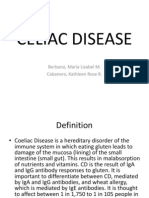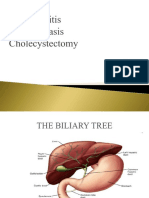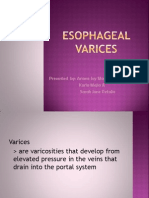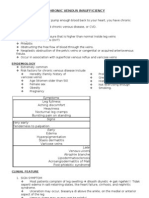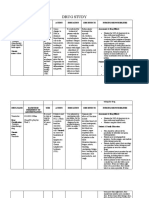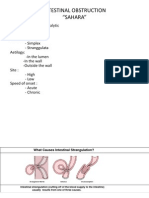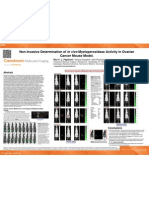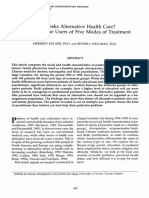Crohn'S Disease Concept Map
Crohn'S Disease Concept Map
Uploaded by
Iris MambuayCopyright:
Available Formats
Crohn'S Disease Concept Map
Crohn'S Disease Concept Map
Uploaded by
Iris MambuayOriginal Title
Copyright
Available Formats
Share this document
Did you find this document useful?
Is this content inappropriate?
Copyright:
Available Formats
Crohn'S Disease Concept Map
Crohn'S Disease Concept Map
Uploaded by
Iris MambuayCopyright:
Available Formats
Cagayan de Oro College PHINMA Education Network
College of Allied Health Sciences
Nursing Department
BSN-3 Medical Surgical Nursing Activity Sheet
2nd Semester, Periodical 1, S.Y. 2020-2021
NAMES:__________MAMBUAY, IRIS JUNE F.__________________________________________ DATE:_02/17/2021______
SECTION:__C1-01___________ C.I:_MS. PHOEBE JAENN TAN, RN_________
CROHN’S DISEASE CONCEPT MAP
NURSING DIAGNOSES RISK FACTORS CROHN’S DISEASE COMPLICATIONS
CLINICAL MANIFESTATIONS
Diarrhea related to inflammatory Heredity Sub-acute and chronic inflammation of the GI Intestinal obstruction/stricture
process Age (occurring usually around 20 – 30 tract wall that extends through all layers; most formation Prominent right lower abdominal
Acute pain related to increased years old) commonly occurs in the distal ileum and the Perianal disease quadrant pain
peristalsis and GI inflammation Being Caucasians ascending colon; “cobblestone appearance Fluid and electrolyte imbalances Chronic diiarrhea unrelieved with
Deficient fluid volume related to Smoking Malnutrition from defecation
anorexia, diarrhea and nausea Chronic use of NSAIDs malabsorption Abdominal tenderness and spasm
Anxiety related to impending Diet Fistula and abscesses formation Crampy pain that appear after meals
ASSESS/DX
surgery Stress Colon cancer (pt’s with colonic Weight loss
Risk for impaired skin integrity Lower socioeconomic status Barium study of upper GI tract Crohn’s disease) Malnutrition
related to malnutrition and CT scan Anorexia Secondary anemia
diarrhea MRI Blood clots Fever
CBC Leukocytosis
Steatorrhea
MANAGEMENT
MEDICAL/SURGICAL NURSING
EIMs (Extraintestinal
Oral fluids Relieve pain and worsening of symptoms
MEDS Manifestations)
Low-residue, high-protein and high-calorie diet Maintain fluid intake
Supplemental vitamins therapy and iron supplement Maintain optimal nutrition by suggesting types of food appropriate Joint disorders
Sulfasalazine
IV therapy if hospitalized for the patient’s diet
Natalizumab Skin lesions
Cold foods and smoking are avoided Promoting rest Ocular disorders
Metronidazole
Sedatives, antidiarrheals and antiperistaltic, corticosteroids and Reduce anxiety through relaxation techniques such as visualization Oral ulcers
Hydrocortisone
immunomodulators medications and deep breathing exercises
Budesonide
Laparoscope-guided strictureplasty Enhancing coping measures
Azathioprine/methotrexate
Small bowel resection with anastomosis Preventing skin breakdown through perianal care
Intestine transplant (children) Monitoring and managing potential complications
Partial or complete colectomy with ileostomy Educating about self –care
You might also like
- Peptic Ulcer Disease (Pud) Concept Map PUDDocument1 pagePeptic Ulcer Disease (Pud) Concept Map PUDIris Mambuay0% (1)
- Peptic Ulcer Disease (Pud) Concept Map PUDDocument1 pagePeptic Ulcer Disease (Pud) Concept Map PUDIris Mambuay0% (1)
- Intensive Care Medicine MCQs Multiple Choice Questions With Explanatory AnswersDocument350 pagesIntensive Care Medicine MCQs Multiple Choice Questions With Explanatory AnswersHiago Sousa59% (17)
- Esophageal Varices Concept MapDocument2 pagesEsophageal Varices Concept MapSureen Regular100% (1)
- MedSurg Notes - Cancer of The LiverDocument2 pagesMedSurg Notes - Cancer of The LiverMae CeaesarNo ratings yet
- IBSDocument1 pageIBSIris MambuayNo ratings yet
- Steps in Conducting Competency AssessmentDocument17 pagesSteps in Conducting Competency Assessmentksj rembulat100% (2)
- Ulcerative Colitis Concept MapDocument1 pageUlcerative Colitis Concept MapIris MambuayNo ratings yet
- Diarrhea Concept MapDocument1 pageDiarrhea Concept MapIris MambuayNo ratings yet
- Gastro Esophageal Reflux Disease (GERD)Document7 pagesGastro Esophageal Reflux Disease (GERD)MahaNo ratings yet
- Hirschsprung DiseaseDocument48 pagesHirschsprung DiseaseKathleen BalauagNo ratings yet
- Gastrointestinal Disorders PnleDocument23 pagesGastrointestinal Disorders Pnledelieup02100% (2)
- Esophageal CancerDocument42 pagesEsophageal Cancerapi-1964133750% (2)
- Peptic Ulcer Dse PathophysiologyDocument19 pagesPeptic Ulcer Dse PathophysiologySymone Jay Lapiz100% (1)
- Celiac DiseaseDocument15 pagesCeliac DiseaseMarty AsisNo ratings yet
- Feeding JejunostomyDocument4 pagesFeeding JejunostomyAbuNo ratings yet
- Gallbladder HydropsDocument6 pagesGallbladder HydropsSaifulAnamNo ratings yet
- Drug LipitorDocument1 pageDrug LipitorSrkocherNo ratings yet
- Hiatal Hernia AchalasiaDocument22 pagesHiatal Hernia AchalasiaDhen MarcNo ratings yet
- Esophageal Varices AMJDocument35 pagesEsophageal Varices AMJAli Al.Juffairi100% (1)
- Cholecystitis Litiasis EctomyDocument23 pagesCholecystitis Litiasis EctomyTimothy WilliamsNo ratings yet
- AppendectomyDocument8 pagesAppendectomyDark AghanimNo ratings yet
- INTUSSUSCEPTIONDocument3 pagesINTUSSUSCEPTIONS GNo ratings yet
- MastectomyDocument12 pagesMastectomykkklllkl100% (1)
- Whipple Procedure Case Study PresentationDocument30 pagesWhipple Procedure Case Study Presentationapi-315408947100% (3)
- Extrahepatic Biliary Tract Pathology - Cholidolithiasis, Cholidocholithiasis, Cholecystitis and CholangitisDocument60 pagesExtrahepatic Biliary Tract Pathology - Cholidolithiasis, Cholidocholithiasis, Cholecystitis and CholangitisDarien LiewNo ratings yet
- PP03L039 - Disorders of The PancreasDocument41 pagesPP03L039 - Disorders of The Pancreasapi-3805855100% (3)
- Acute Cholecystitis SeminarDocument42 pagesAcute Cholecystitis SeminarNatnaelNo ratings yet
- Pancreatic CancerDocument25 pagesPancreatic CancerAatir JavaidNo ratings yet
- Biomedical Case StudyDocument5 pagesBiomedical Case StudyHannan AtharNo ratings yet
- Gastric CancerDocument7 pagesGastric CancerMuhadis AhmadNo ratings yet
- Carcinoma Stomach: Pathophysiology & Management DR Gireesh G NDocument77 pagesCarcinoma Stomach: Pathophysiology & Management DR Gireesh G NArunNo ratings yet
- Esophageal VaricesDocument14 pagesEsophageal VaricesKarla So Mejia100% (1)
- Gastroesophageal Cancer (Case Study)Document66 pagesGastroesophageal Cancer (Case Study)Michelle DuNo ratings yet
- Chronic Venous InsufficiencyDocument4 pagesChronic Venous Insufficiencyfandi_cah_ganteng3367100% (1)
- Perforated Peptic UlcerDocument68 pagesPerforated Peptic UlcerSaibo BoldsaikhanNo ratings yet
- Esophageal VaricesDocument4 pagesEsophageal VaricesSnapeSnapeNo ratings yet
- Summary Case Peptic Ulcer and PeritonitisDocument8 pagesSummary Case Peptic Ulcer and PeritonitissyududNo ratings yet
- Colon, Rectum and AnusDocument30 pagesColon, Rectum and AnusKiara GovenderNo ratings yet
- Acute Myeloid Leukemia (Drug Study)Document3 pagesAcute Myeloid Leukemia (Drug Study)Krisianne Mae Lorenzo FranciscoNo ratings yet
- 10 Golden Rules of IV TherapyDocument8 pages10 Golden Rules of IV Therapybbasya eihynaNo ratings yet
- Crohn's Disease Seminar FinalDocument27 pagesCrohn's Disease Seminar Finalshahad alshareefNo ratings yet
- Esophageal CancerDocument3 pagesEsophageal CancerChanthorn SokNo ratings yet
- Pathophysiology of Varicose Vein - Chronic Venous InsufficiencyDocument31 pagesPathophysiology of Varicose Vein - Chronic Venous InsufficiencyDavid Christian100% (1)
- Complication of Peptic Ulcer: Department of Surgery S. S. Medical College Rewa and Associate GMH and SGMH RewaDocument76 pagesComplication of Peptic Ulcer: Department of Surgery S. S. Medical College Rewa and Associate GMH and SGMH RewaBrajesh MouryaNo ratings yet
- Case UreterolithiasisDocument26 pagesCase UreterolithiasisPutri Dwi Kartini0% (1)
- Intestinal ObstructionDocument12 pagesIntestinal ObstructionNurul Nurnita100% (1)
- Urinary RetentionDocument6 pagesUrinary RetentionAiza Apelada-NievaNo ratings yet
- Liver Case StudyDocument6 pagesLiver Case StudyGhulam MustafaNo ratings yet
- Liver Function TestDocument3 pagesLiver Function TestMahmoud FathallaNo ratings yet
- Signs & Symptoms of Pregnancy-4Document1 pageSigns & Symptoms of Pregnancy-4phoenix180100% (1)
- Management of Upper Gi BleedingDocument41 pagesManagement of Upper Gi Bleedingkaukab azimNo ratings yet
- The Cardiovascular System: The Heart: AnatomyDocument76 pagesThe Cardiovascular System: The Heart: AnatomyDeepuNo ratings yet
- 8D Gastrointestinal FinalwithdxDocument27 pages8D Gastrointestinal FinalwithdxGlenn Daryll SantosNo ratings yet
- Bailey & Love Bailey & Love Bailey & Love Bailey & Love Bailey & Love Bailey & LoveDocument12 pagesBailey & Love Bailey & Love Bailey & Love Bailey & Love Bailey & Love Bailey & LoveSaifianNo ratings yet
- Cervical Cancer ChemotherapyDocument6 pagesCervical Cancer ChemotherapyTheeya Quigao0% (1)
- Advanced GI Nursing CareDocument13 pagesAdvanced GI Nursing CareBobbi-MarieNo ratings yet
- Nursing Care of Patient With Digestive IndexDocument28 pagesNursing Care of Patient With Digestive IndexAngela FerrerNo ratings yet
- Post-Menopausal BleedingDocument16 pagesPost-Menopausal BleedingRohan Prem NairNo ratings yet
- Ventricular Septal Defect, A Simple Guide To The Condition, Treatment And Related ConditionsFrom EverandVentricular Septal Defect, A Simple Guide To The Condition, Treatment And Related ConditionsNo ratings yet
- Concept Map For Gastroesophageal Reflux Disease (Gerd)Document1 pageConcept Map For Gastroesophageal Reflux Disease (Gerd)Iris MambuayNo ratings yet
- Appendicitis Concept MapDocument1 pageAppendicitis Concept MapIris MambuayNo ratings yet
- Constipation Concept MapDocument1 pageConstipation Concept MapIris MambuayNo ratings yet
- Concept Map For Gastroesophageal Reflux Disease (Gerd)Document1 pageConcept Map For Gastroesophageal Reflux Disease (Gerd)Iris MambuayNo ratings yet
- Constipation Concept MapDocument1 pageConstipation Concept MapIris MambuayNo ratings yet
- MCN NCPDocument6 pagesMCN NCPIris MambuayNo ratings yet
- Procedures in ORDocument10 pagesProcedures in ORIris MambuayNo ratings yet
- Reflection On Webinar About Healthy Living During The PandemicDocument2 pagesReflection On Webinar About Healthy Living During The PandemicIris MambuayNo ratings yet
- Pediatric DosesDocument17 pagesPediatric DosesIris MambuayNo ratings yet
- Botulism: BSN Ii - ADocument11 pagesBotulism: BSN Ii - AIris MambuayNo ratings yet
- Maternal and Child Health Nursing QuestionnaireDocument5 pagesMaternal and Child Health Nursing QuestionnaireIris Mambuay100% (1)
- Theories and Principles of Health EthicsDocument21 pagesTheories and Principles of Health EthicsIris MambuayNo ratings yet
- Theories and Principles of Health EthicsDocument2 pagesTheories and Principles of Health EthicsIris MambuayNo ratings yet
- Request For Health ExaminationsDocument6 pagesRequest For Health ExaminationsNitin SNo ratings yet
- Postpartum Health TeachingDocument6 pagesPostpartum Health TeachingAnn Michelle TarrobagoNo ratings yet
- Municipal General Election 2022 Gobardanga Municipality: Order of Appointment For Water CarrierDocument48 pagesMunicipal General Election 2022 Gobardanga Municipality: Order of Appointment For Water CarrierSudipta SahaNo ratings yet
- AACR 2012 - Ovarian Cancer Model and Microenvironment Differences - Dr. Rao PapineniDocument1 pageAACR 2012 - Ovarian Cancer Model and Microenvironment Differences - Dr. Rao PapineniPapineni LabsNo ratings yet
- Neuro Vital Signs FormDocument2 pagesNeuro Vital Signs FormAbegail Tabuniag100% (1)
- Prodhive: B.A.S.H 5.0Document9 pagesProdhive: B.A.S.H 5.0Goverdhan Gupta 4-Yr B.Tech.: Mechanical Engg., IIT(BHU)No ratings yet
- PE Stress Management and Relaxation TechniquesDocument1 pagePE Stress Management and Relaxation Techniquesjefferylj888No ratings yet
- 5 Essential Differences Between True Love and Toxic Love - by Karen Nimmo - On The Couch - Nov, 2020 - MediumDocument5 pages5 Essential Differences Between True Love and Toxic Love - by Karen Nimmo - On The Couch - Nov, 2020 - MediumDóra NovákNo ratings yet
- Who Seeks Alternative Health Care? A Profile of The Users of Five Modes of TreatmentDocument14 pagesWho Seeks Alternative Health Care? A Profile of The Users of Five Modes of TreatmentEdward Joshua NuguidNo ratings yet
- Hotel FacilitiesDocument45 pagesHotel FacilitiesBEATRIZ MORALES ALBANo ratings yet
- CARE OF CLIENTS WITH MALADAPTIVE PATTERNS OR BAHAVIOR - PrelimsDocument11 pagesCARE OF CLIENTS WITH MALADAPTIVE PATTERNS OR BAHAVIOR - PrelimsKrisha CafongtanNo ratings yet
- Health and Safety Management RequirementsDocument28 pagesHealth and Safety Management RequirementsjansherkakkandamNo ratings yet
- Soal Ujian Sekolah SMPDocument13 pagesSoal Ujian Sekolah SMPariyantoNo ratings yet
- P 2Document12 pagesP 2Uday kumarNo ratings yet
- Auditing and Monitoring-ChecklistDocument6 pagesAuditing and Monitoring-Checklistprince bansalNo ratings yet
- Preschooler G&DDocument5 pagesPreschooler G&DABISHAK RAVIKUMARNo ratings yet
- Electro 3 PrefinalsDocument5 pagesElectro 3 PrefinalsJuan Miguel TorresNo ratings yet
- Asahi AN (SDS)Document15 pagesAsahi AN (SDS)HaziqNo ratings yet
- Hamad - alhusaini@NHRA - BH Saad - rashed@NHRA - BH WWW - Nhra.bhDocument5 pagesHamad - alhusaini@NHRA - BH Saad - rashed@NHRA - BH WWW - Nhra.bhKazi MohammedNo ratings yet
- IYSADocument13 pagesIYSAAhmad HariyonoNo ratings yet
- Philippine EHealth Systems and Services Act GROUP 5Document54 pagesPhilippine EHealth Systems and Services Act GROUP 5Yvette SadacNo ratings yet
- Essay indomie-RAFLYDocument6 pagesEssay indomie-RAFLY221 Rafly Rahmadafa SyabaniNo ratings yet
- Midterm Pharma 19Document11 pagesMidterm Pharma 19Mark Jheran Alvarez100% (1)
- English Drama ScriptDocument4 pagesEnglish Drama ScriptLestariNo ratings yet
- Report of The Second Conference in Zielona Gra Palliative Medicine Supportive Care and Pain Management in Cancer Patients - 2023 - Via MedicaDocument7 pagesReport of The Second Conference in Zielona Gra Palliative Medicine Supportive Care and Pain Management in Cancer Patients - 2023 - Via MedicaftasiaNo ratings yet
- Cunningham - Perceptions of Outcomes of Orthodontic Treatment in Adolescent Patients - A Qualitative StudyDocument21 pagesCunningham - Perceptions of Outcomes of Orthodontic Treatment in Adolescent Patients - A Qualitative StudyMilton david Rios serratoNo ratings yet
- Police Stress Literature ReviewDocument4 pagesPolice Stress Literature Reviewgw0drhkf100% (1)
- PDF Lean and Mean Blueprint Manual DLDocument18 pagesPDF Lean and Mean Blueprint Manual DLpraveenNo ratings yet













